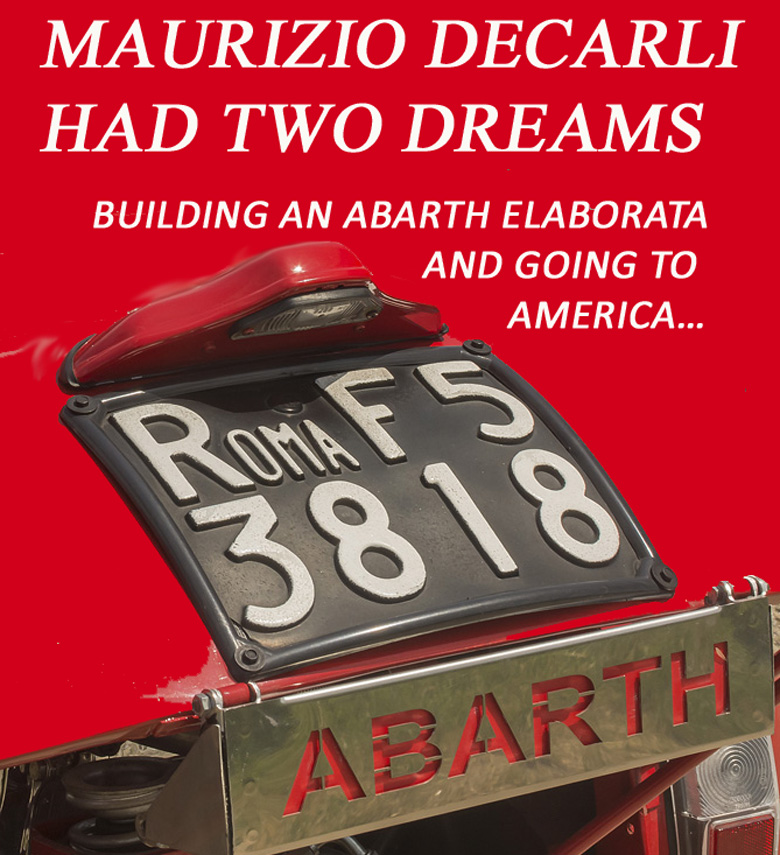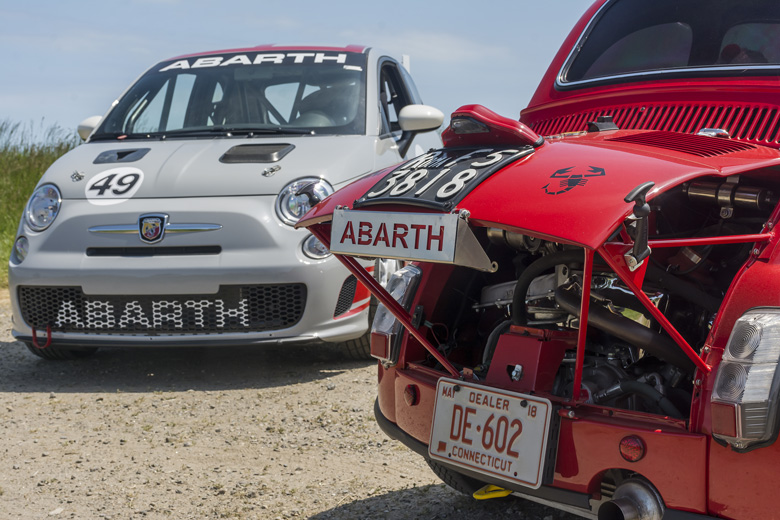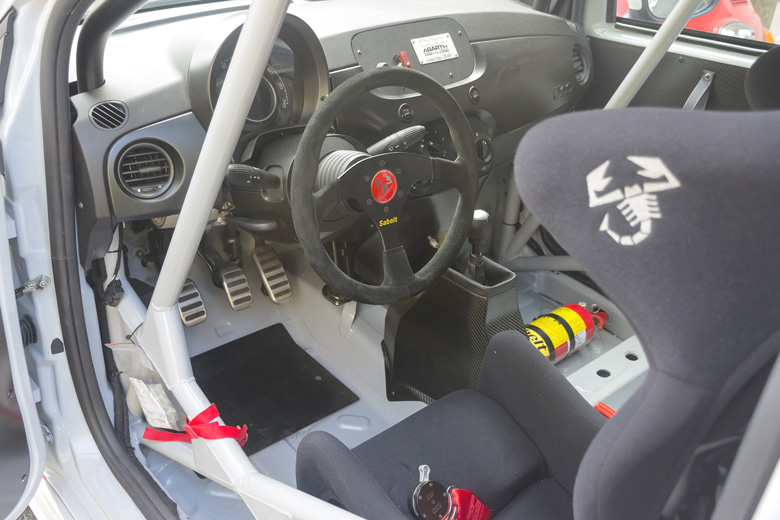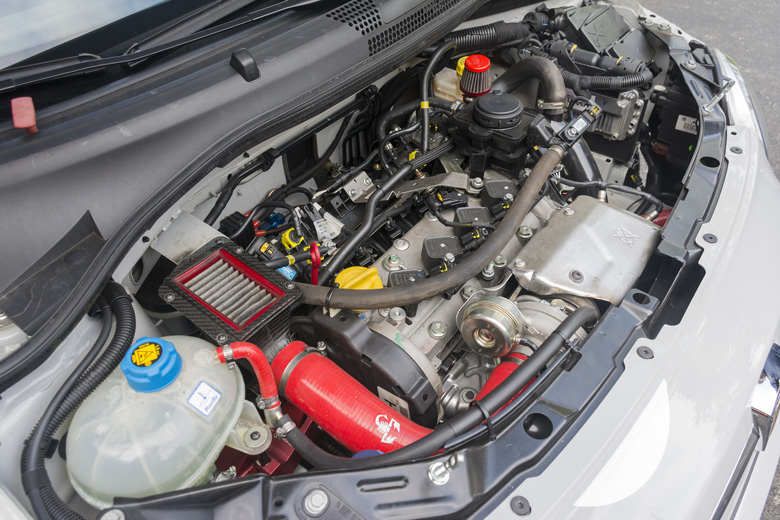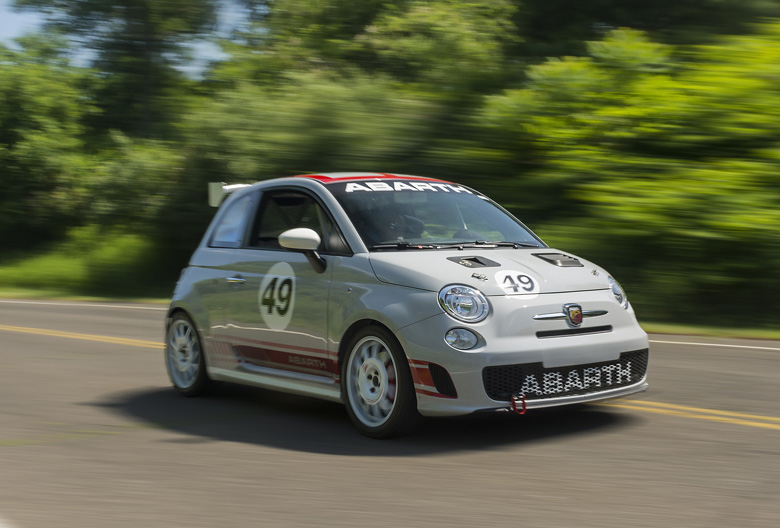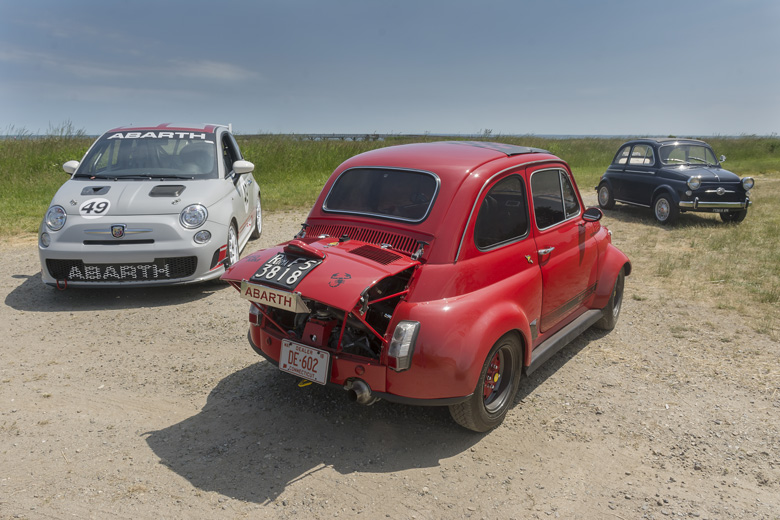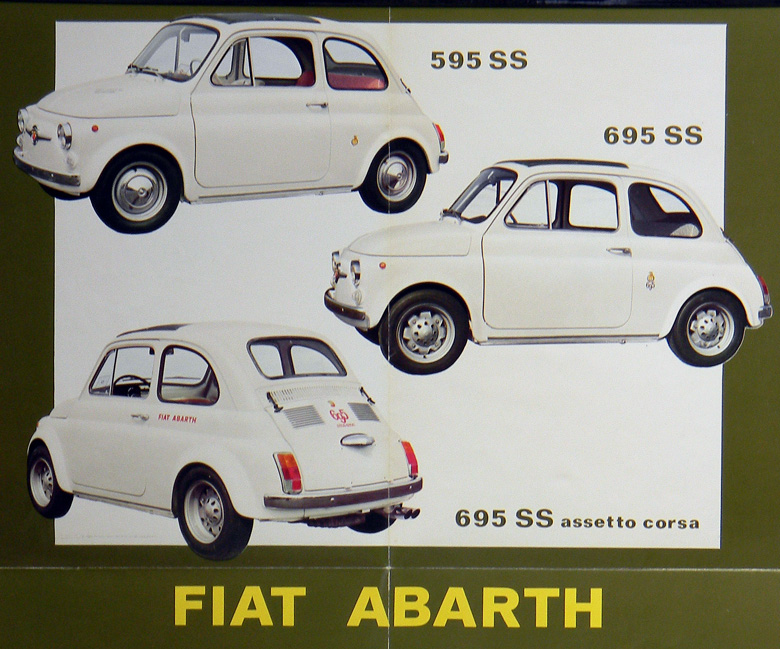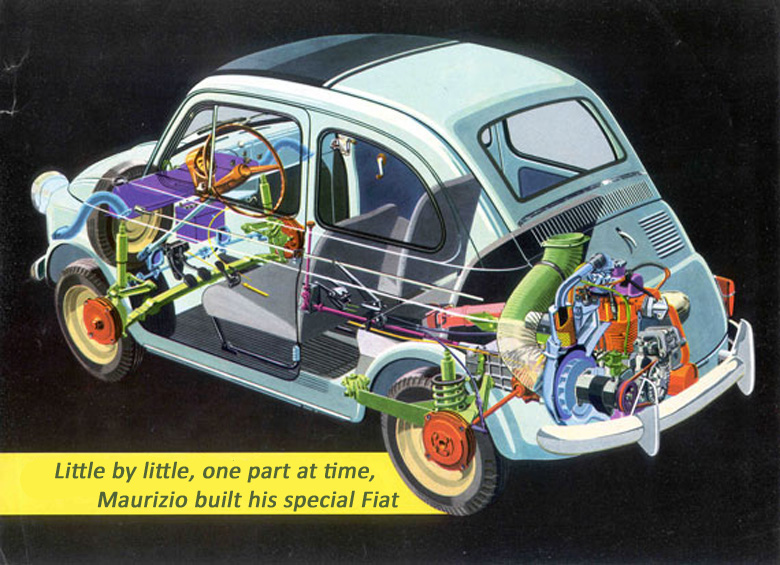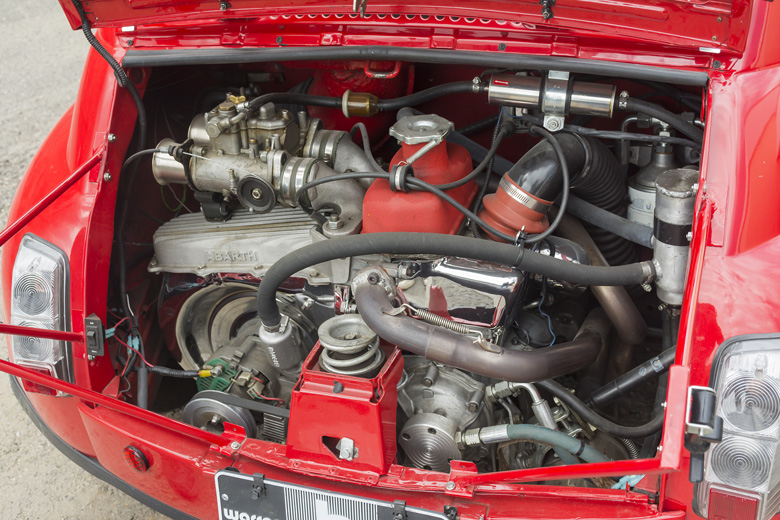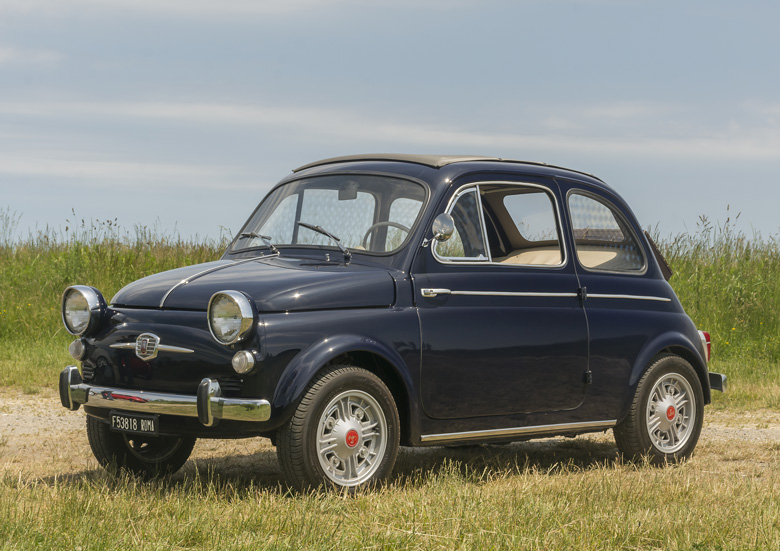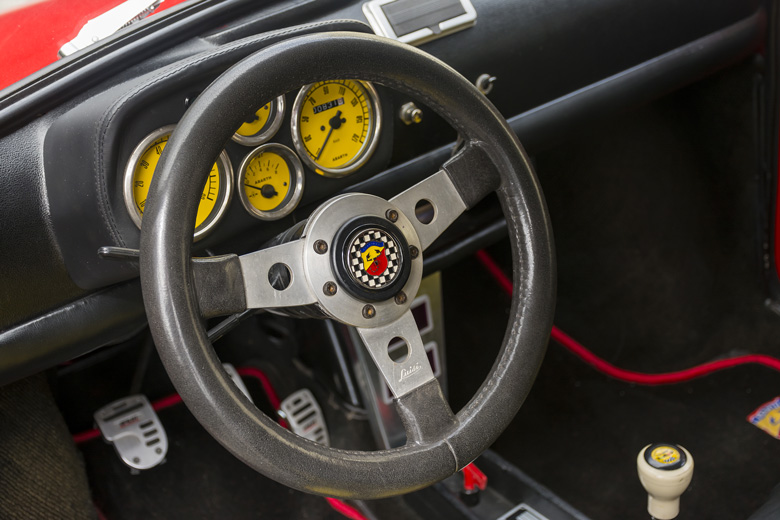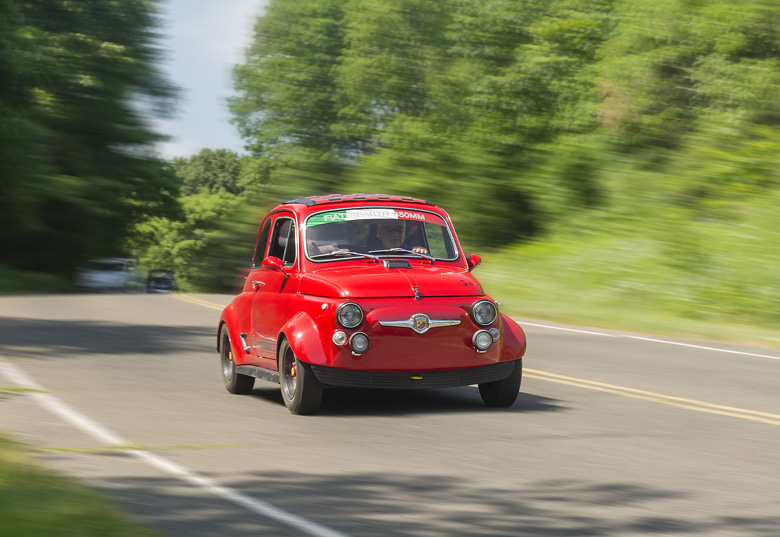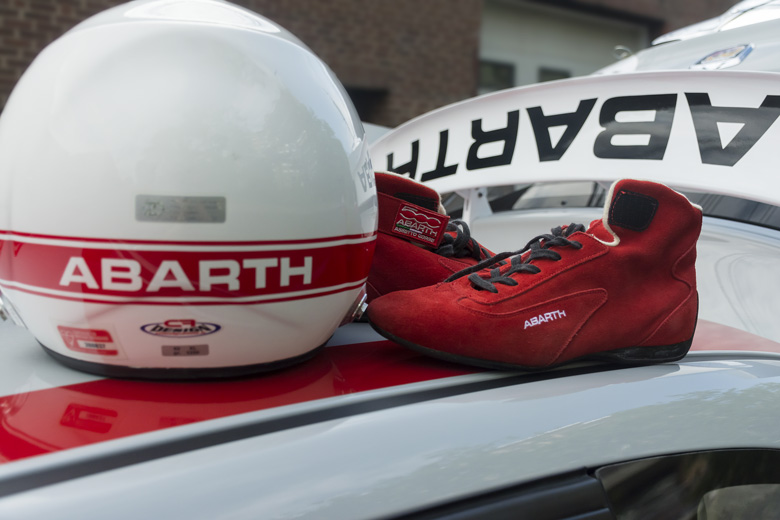Story by Sean Smith
When Santo Spadaro of Dominick European Cars tells you “I have a few cool Fiat-Abarths I think you would like to see,” the only sane answer is “Where, and when?”
Arriving at his garage in Westchester NY, the first car is waiting: a 2008 Abarth 500 Assetto Corse. Fiat wanted to make an impression with the revival of the Abarth tuning division, and they did that with a special limited edition auto. This is a track-centric machine, but it has a dealer plate on it, so no problem. It is number 26 of 49 built. Lucky owners could have any color they wanted, as long as it was grey.
This is NOT your Padre’s 500! This is a front wheel drive, inline 4 cylinder with 4 valves per cylinder, along with a Garrett GT 1446 fixed geometry turbocharger pushing the 1368 cc engine to 200bhp at 6500 rpm, and max torque of 221 ft/lbs at 3000 rpm. The car just weighs just a hair over 2000 pounds, so it is molto rapidamente. The stripped-out interior with carbon fiber door panels, racing seat, roll bar and fire suppression system doesn’t leave you guessing what the car is meant to do. But in case you have other ideas, the Brembo brakes, OZ racing wheels and large rear wing drive the point home.
It is a visceral, binary apparatus. There are a lot of on-off switches. The brakes are an on-off switch, the gas pedal is an on-off switch. Using those items, the Abarth reacts instantly. It’s good to be strapped into the racing seat when you apply the brakes so your internal organs don’t end up in the engine compartment. Same can be said for the gas pedal, only everything will be going in the other direction. There is no turbo lag, power is immediate. Just a whistle and the sound of the waste gate and you’re in another dimension. Just be very aware of the torque steer! There is so much torque it will easily move away from idle in any gear. Steering is laser sharp, so you become very gentle with the input.
The closest the road-going version comes to the Assetto Corse is the Abarth badge on its flank.
The Italian spirit and inspiration lives deep, whether it’s a bespoke interpretation of the maestro’s original creation or the modern version. They’d both make Carlo smile.
After a spirited drive to Connecticut, we arrive at J&M Auto Body owned by Maurizio Decarli, a man Carlo Abarth would be happy to sit with and share a glass of wine. Mario’s story of his red Fiat Nuova 500 is as classic as the car itself.
Apprenticeship by fire
Maurizio started his apprenticeship in a body shop after fifth grade at ten years old. For the first year, he swept the floors and made sure all the tools were put back in their proper places on the wall. All for no pay. In his second year he was given rubbing compound in one hand and cotton in the other, and spent his time learning the feel of using his hands. Next step was sand paper in the palm of his hand—again, learning the touch, the feel, of making shapes smooth.
At age 13 they handed him the spray gun filled with primer. He was a body man! He was a painter! Maurizio though he was God!
By 14 he was using a dolly and hammer, so he could do his little jobs start to finish. At 16 he went to work at a Fiat dealership. He was paid enough to afford 3 cigarettes a day and ice cream. Perhaps Maurizio gazed at the poster below from the 1960s and was inspired to create his own Abarth. 695 Assetto Corsa.
The owner’s son bought a big place in Rome to sell Lamborghinis, Ferraris Maseratis, Mercedes—all high-end autos. Maurizio was drafted into the new body shop. The place was populated with many grand masters who taught the young man all their tricks. At 17 he was given a job. “Maurizio, we need this quick!” “Ah—no problem!” A yellow Lamborghini Miura. On the front of the beautiful car was a dent. Maurizio started banging away.
This metal was different… What’s the matter with this metal? I can’t make it do what I want… Time for the torch! Heat was applied to make the metal nice and red so he could work with it better, but the metal never turned red. Next thing POP! A hole!
Aluminum.
Maurizio had never worked in aluminum. At that moment— thoughts of emigrating may have crossed his mind—luckily, one of the old guys came over, cut a small piece of aluminum, and gave him a lesson in working with the material. A true baptism by fire
Gotta get a car…
Some days he could use the family car to get to work, but getting up at 5 am to catch the bus and returning home at 9 pm was getting very old. He needed his own car. He’d been planning ahead. He was going to build his own Fiat. While working in the first body shop, he’d find a hood that had been discarded. Tap, tap, tap he would ply his trade on it, and put it away. Then the rear trunk lid: tap, tap, tap, put it away. Then a door and so on. He then saved up to buy a motor; off it went to live with all the other parts. He was then able to buy, for peanuts, the leftovers from a stolen car—a rolling Fiat 500 chassis with everything missing—but he had all the parts. So little by little, for almost no money, Maurizio built his car.
In 1974 Maurizio left Italy to pursue the American dream. Over the years he built a successful business and, by 1990, brought his parents and his Fiat to America.
He now had money to spend and years of experience to create the car of his dreams. He started modifying a Fiat two cylinder 650 block and added a nice carburetor, oil pan, and muffler: all Abarth stuff. But he still wasn’t happy, and wanted more. He attacked the body with all his knowledge and ability and hand-formed steel flared fenders to fit perfectly over the more meaty tires he’d added.
Still not enough. A year or so later Maurizio bought a complete 700cc Abarth engine to power his creation. He proceeded to blow that one up. To paraphrase, “there is no substitute for cubic centimeters.” He moved up to an 800cc power plant, again adding all the Abarth speed equipment he could lay his hands on. The next step was to add a 5 speed gearbox for better highway cruising, A little modification here, a little there, and it was in. The little Fiat that could now had to also be the little Fiat that could stop, so front and rear disc brakes were added.
The little red car and Maurizio have been together for years now. All other cars and his home would be sold, but not his bambino. “It’s going in the ground with me!” A true long lasting love affair.
Maurizio, like Carlo Abarth, saw the potential in the little Fiat, and both created fire-breathing giant killers.
Maurizio also did a faithful restoration on a Nuova 500 showing the starting point that he and Carlo used to embark on, many years apart. While not exactly stock, his Nuova 500, (see below) complete with frog eye headlights, gives one an idea of just how far the red Fiat progressed.
In Italian, you would call Maurizio’s red creation elaborata or Spinta. The car has been taken to the limit, but at the limit is just right.
One can appreciate all the years of hard work Maurizio has put in as you walk around his wonderful little creation. All the details, style and fun come together to put a smile on your face from 20 feet away. As you get closer the smile only gets bigger and when you squeeze inside bigger still.
Abarth style has been applied generously throughout the interior, from the gage cluster to the small diameter steering wheel and the body gripping seats all with the ubiquitous scorpion emblazoned on them. With the combination of extra rubber, suspension improvements and that small wheel the Fiat is so responsive it makes turns as fast as you can think about them, while always feeling planted firmly on the road. The little machine is quick and fast; even with a 48mm carburetor on an 800cc engine there are no dead spots in the rev range.
Put your foot down and arrivederci! With all the huge numbers quoted on horsepower these days the Abarth’s 65hp doesn’t sound like enough to get you rolling down a hill, but this machine is light, around 1,146 lbs. Maurizio can pick up the front by himself (a method he used to use in Rome. Not happy with your parking? Pick it up and rearrange it.) So this little giant killer is good for 170 kph or about 105 in mph that is pretty respectable for two cylinders. The disc brakes at all four corners give you plenty of arresto. Is there anything more Maurizio could do to his car? No, basta, enough!
The Italian spirit and inspiration lives deep, whether it’s a bespoke interpretation of the maestro’s original creation or the modern version. They’d both make Carlo smile.
